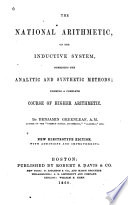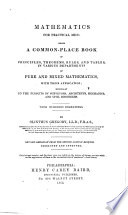 | Elias Loomis - 1858 - 394 σελίδες
...difference — .§-, and the last term — 21-J. Ans. Number of terms 25, and sum of terms — 281-y. Ex. 5. The first term of an arithmetical progression is 5, the last term 23, and the sum of the terms 392. What is the common difference and the number of terms? Ans. Common... | |
 | Benjamin Greenleaf - 1858 - 456 σελίδες
...the number of common differences, 21, gives 2 as the common difference required. RULE. — Dh-itle the difference of the extremes by the number of terms less one, and the quotient will be the common difference. EXAMPLES. 2. A certain school consists of 19 teachers... | |
 | Horatio Nelson Robinson - 1859 - 348 σελίδες
...thus, by taking away 2 in the fifth term, 2-J-3 + 3 + 3 + 3, we have 3 taken 4 times. Hence, RULE. Divide the difference of the extremes by the number of terms less one. EXAMPLES. 1. The first term is 2, the last term is 17, and the number of terms is 6 ; what is the common difference ? Ant. 3. 2.... | |
 | Silas Lawrence Loomis - 1859 - 324 σελίδες
...PROB. CLIII. — GIVEN, THE EXTREMES AND NUMBER OF TERMS, TO FIND THE COMMON DIFFERENCE AND MEANS. RULE Divide the difference of the extremes by the number of terms, less one, for the common difference. Then construct the series by P/ob. CL. PROB. CLIV. — GIVEN, THE EXTREMES... | |
 | Benjamin Greenleaf - 1860 - 456 σελίδες
...divided by the number of common differences, 21, gives 2 as the common difference required. RULE. — Divide the difference of the extremes by the number of terms less one, and the quotient will be the common difference. EXAMPLES. 2. A certain school consists of 19 teachers... | |
 | Horatio Nelson Robinson - 1860 - 444 σελίδες
...the common difference multiplied by the number of terms less 1, (706), we have the following RULE. Divide the difference of the extremes by the number of terms less 1. EXAMPLES FOR PRACTICE. 1. If the extremes of an arithmetical series are 3 and 15, and the number... | |
 | Emerson Elbridge White - 1861 - 348 σελίδες
...The first term, number of terms, and last term being given to find the common difference. RULE. — Divide the difference of the extremes by the number of terms, less one. (3). The first term, common difference, and last term being given to find the number of terms. RULE.... | |
 | James Stewart Eaton - 1862 - 320 σελίδες
...difference, divided by 3 (15 -s- 3 = 5), gives one of these additions, ie the common difference. Hence, RULE. Divide the difference of the extremes by the number of terms less one, and the quotient will be the common difference. Ex. 1. The extremes of an arithmetical series are 3... | |
 | Olinthus Gregory - 1863 - 482 σελίδες
...a series of odd numbers beginning with unity, would be = n', the square of the number of terms. 2. The first term of an arithmetical progression is 5, the last . term 41, the sum 299. Required the number of the terms, and the common difference. 2s 598 Here n = — —... | |
 | James Stewart Eaton - 1864 - 322 σελίδες
...difference, divided by 3 (16 -=-3 = 5), gives one of these additions, ie the common difference. Hence, RULE. Divide the difference of the extremes by the number of terms less one, and the quotient will be the common difference. Ex. 1. The extremes of an arithmetical series are 3... | |
| |